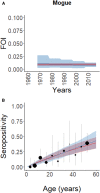Endemic and Epidemic Human Alphavirus Infections in Eastern Panama: An Analysis of Population-Based Cross-Sectional Surveys
- PMID: 33124532
- PMCID: PMC7695115
- DOI: 10.4269/ajtmh.20-0408
Endemic and Epidemic Human Alphavirus Infections in Eastern Panama: An Analysis of Population-Based Cross-Sectional Surveys
Abstract
Madariaga virus (MADV) has recently been associated with severe human disease in Panama, where the closely related Venezuelan equine encephalitis virus (VEEV) also circulates. In June 2017, a fatal MADV infection was confirmed in a community of Darien Province. We conducted a cross-sectional outbreak investigation with human and mosquito collections in July 2017, where sera were tested for alphavirus antibodies and viral RNA. In addition, by applying a catalytic, force-of-infection (FOI) statistical model to two serosurveys from Darien Province in 2012 and 2017, we investigated whether endemic or epidemic alphavirus transmission occurred historically. In 2017, MADV and VEEV IgM seroprevalences were 1.6% and 4.4%, respectively; IgG antibody prevalences were MADV: 13.2%, VEEV: 16.8%, Una virus (UNAV): 16.0%, and Mayaro virus: 1.1%. Active viral circulation was not detected. Evidence of MADV and UNAV infection was found near households, raising questions about its vectors and enzootic transmission cycles. Insomnia was associated with MADV and VEEV infections, depression symptoms were associated with MADV, and dizziness with VEEV and UNAV. Force-of-infection analyses suggest endemic alphavirus transmission historically, with recent increased human exposure to MADV and VEEV in Aruza and Mercadeo, respectively. The lack of additional neurological cases suggests that severe MADV and VEEV infections occur only rarely. Our results indicate that over the past five decades, alphavirus infections have occurred at low levels in eastern Panama, but that MADV and VEEV infections have recently increased-potentially during the past decade. Endemic infections and outbreaks of MADV and VEEV appear to differ spatially in some locations of eastern Panama.
Conflict of interest statement
Disclaimer: The opinions expressed by authors contributing to this journal do not necessarily reflect the opinions of the Gorgas Memorial Institute of Health Studies, the Panamanian government, or the institutions with which the authors are affiliated. Conflicts that the editor considers relevant to the content have been disclosed.
Figures




References
-
- Navarro JC, Carrera JP, Liria J, Auguste AJ, Weaver SC, 2017. Alphaviruses in Latin America and the introduction of chikungunya virus. JE Ludert, FH Pujol, J Arbiza (eds). Human Virology in Latin America. Cham, Switzerland: Springer International Publishing, 169–192.
-
- Weaver SC, Salas R, Rico-Hesse R, Ludwig GV, Oberste MS, Boshell J, Tesh RB, 1996. Re-emergence of epidemic Venezuelan equine encephalomyelitis in South America. VEE Study Group. Lancet 348: 436–440. - PubMed
-
- Borgherini G, Poubeau P, Staikowsky F, Lory M, Le Moullec N, Becquart JP, Wengling C, Michault A, Paganin F, 2007. Outbreak of chikungunya on Reunion Island: early clinical and laboratory features in 157 adult patients. Clin Infect Dis 44: 1401–1407. - PubMed
-
- Aguilar PV, et al. 2007. Endemic eastern equine encephalitis in the Amazon region of Peru. Am J Trop Med Hyg 76: 293–298. - PubMed
Publication types
MeSH terms
Substances
Grants and funding
LinkOut - more resources
Full Text Sources
Miscellaneous

